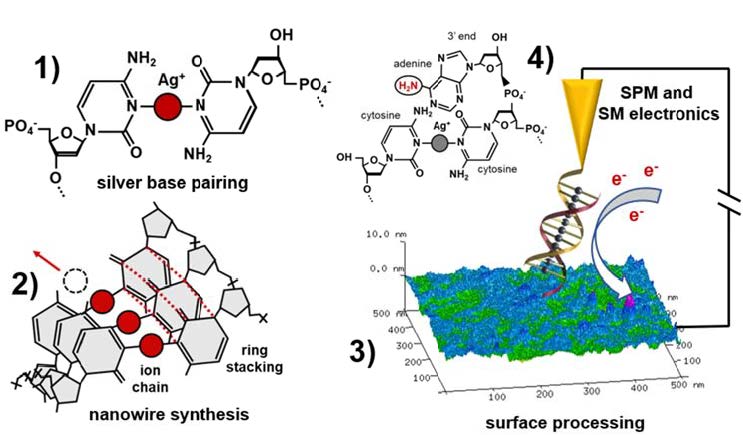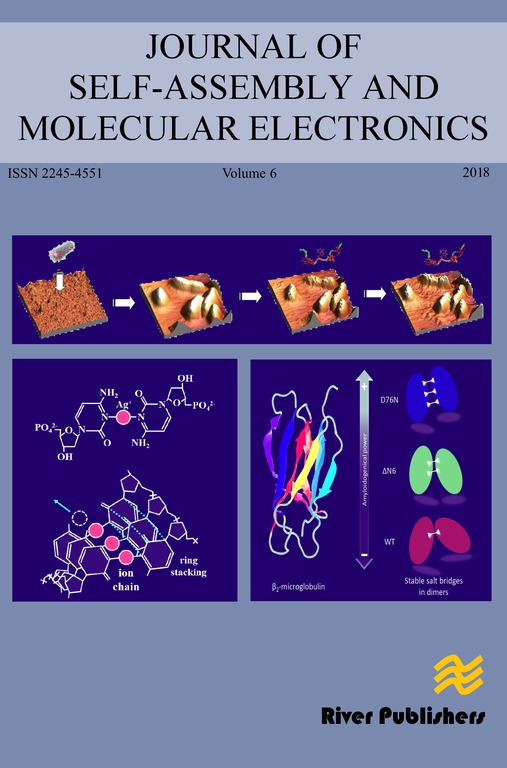Methods of Synthesis and Characterization of Conductive DNA Nanowires Based on Metal Ion-Mediated Base Pairing for Single-Molecule Electronics
DOI:
https://doi.org/10.13052/jsame2245-4551.6.004Keywords:
Molecular electronics, DNA nanowire, nanomaterials, cytosine mismatch, methods.Abstract
Advances in the field of molecular electronics have made possible the direct
measurement of charge transport across single molecules. In particular, work
on DNA oligomers has demonstrated that this weakly-conducting biomolecule
can be functionalized through metal-mediated nucleobase pairing in order to
significantly increase electron mobility across the molecule. The introduction
of interacting stacks of single metal ions inside the DNA helix is an attractive
platform for assay and optimization; for this reason we present a protocol
for the production and processing of nanowires with a metal base pair for
single-molecule applications. In particular, we describe the construction of DNA duplex wires with a cytosine-Ag+-cytosine base pair (dC:Ag+:dC).
A thorough investigation of buffer components suggests the use of divalent
magnesium counterions to stabilize highly mismatched oligonucleotides in
solution. We further analyse cleaning and processing of thin gold films for
batch-fabrication of conductive imaging substrates for use in conductive
scanning probe assays of single-molecule conductivity. With a clear path to
electrical assays, we suggest that the C:Ag+:C orthogonal nucleotide pair and
other similar chemistries may provide a foundation for molecular electronic
components in integrated devices
Downloads
References
E. Braun, et al. ‘DNA-templated assembly and electrode attachment of
a conducting silver wire’, Nature, 391(6669):775–778, 1998.
L. Montagnier, et al. ‘Electromagnetic signals are produced by aqueous
nanostructures derived from bacterial DNA sequences’, Interdisciplinary
Sciences: Computational Life Sciences, 1(2):81–90, 2009.
A. Storm, et al. ‘Insulating behavior for DNA molecules between
nanoelectrodes at the 100 nm length scale’, Applied Physics Letters,
(23):3881–3883, 2001.
A. Y. Kasumov, et al. ‘Proximity-induced superconductivity in DNA’,
Science, 291(5502): 280–282,2001.
G. I. Livshits, et al. ’Long-range charge transport in single G-quadruplex
DNA molecules’, Nature Nanotechnology, (9): 1040–1046, 2014.
L. Xiang, et al. ‘Intermediate tunnelling–hopping regime in DNA charge
transport’, Nature Chemistry, 7(3):221–226, 2015.
L. Venkataraman, et al. ‘Dependence of single-molecule junction conduc-
tance on molecular conformation’, Nature, 442(7105):904–907, 2006.
C. Bruot, et al. ‘Effect of mechanical stretching on DNA conductance’,
ACS Nano, 9(1):88–94, 2014.
B. Xu, et al. ‘Direct conductance measurement of single DNA molecules
in aqueous solution’, Nano Letters, 4(6):1105–1108, 2004.
E. Toomey, et al. ‘Comparison of Canonical versus Silver(I)-Mediated
Base-Pairing on Single Molecule Conductance in Polycytosine dsDNA’,
Journal of Physical Chemistry C, 120(14):7804–7809, 2016.
H. Torigoe, et al. ‘Thermodynamic and structural properties of the
specific binding between Ag(+) ion and C:C mismatched base pair in
Methods of Synthesis and Characterization of Conductive DNA Nanowires 87
duplex DNA to form C-Ag-C metal-mediated base pair’, Biochimie,
(11):2431–2440, 2012.
Y. Miyake, et al. ‘MercuryII-mediated formation of thymine-HgII-
thymine base pairs in DNA duplexes’, Journal of the American Chemical
Society, 128(7):2172–2173, 2006.
S. Johannsen, et al. ‘Solution structure of a DNA double helix with con-
secutive metal-mediated base pairs’, Nature Chemistry, 2(3):229–234,
G. H. Clever, M. Shionoya, ‘Metal-base pairing in DNA’, Coordination
Chemistry Reviews, 254(19–20): 2391–2402, 2010.
V. B. Pinheiro, P. Holliger, ‘Towards XNA nanotechnology: new
materials from synthetic genetic polymers’, Trends in Biotechnology,
(6):321–328, 2014.
H. Yamaguchi, et al. ‘The structure of metallo-DNA with consecutive
thymine-HgII-thymine base pairs explains positive entropy for the met-
allo base pair formation’, Nucleic Acids Research, 42(6):4094–4099,
S. S. Mallajosyula, S. K. Pati, ‘Conformational tuning of magnetic inter-
actions in metal–DNA complexes’, Angewandte Chemie, 121(27):5077–
, 2009.
S. Roche, ‘Sequence dependent DNA-mediated conduction’, Physical
Review Letters, 91(10):108101, 2003.
S. S. Mallajosyula, S. K. Pati, ‘Toward DNA conductivity: a theoretical
perspective’, The Journal of Physical Chemistry Letters, 1(12):1881–
, 2010.
H. Torigoe, et al. ‘Thermodynamic properties of the specific binding
between Ag+ ions and C:C mismatched base pairs in duplex DNA’,
Nucleotides, Nucleosides and Nucleic Acids, 30:149–167, 2011.
S. M. Swasey, et al. ‘Silver (I) as DNA glue: Ag+-mediated guanine
pairing revealed by removing Watson-Crick constraints’, Scientific
reports, 5: 10163, 2015.
L. Venkataraman, et al. ‘Single-molecule circuits with well-defined
molecular conductance’, Nano Letters, 6(3):458–462, 2006.
A. Ono, et al. ‘Specific interactions between silver(I) ions and cytosine-
cytosine pairs in DNA duplexes’, Chemical Communications (Cam-
bridge), (39):4825–4827, 2008.
N. Peyret, et al. ‘Nearest-neighbor thermodynamics and NMR of
DNA sequences with internal A.A, C.C, G.G, and T.T mismatches’,
Biochemistry, 38(12):3468–3477, 1999.
S. Vecchioni et al.
R. Owczarzy, et al. ‘Predicting stability of DNA duplexes in solu-
tions containing magnesium and monovalent cations’, Biochemistry,
(19):5336–5353, 2008.
J.-L. Leroy, et al. ‘Intramolecular folding of a fragment of the cytosine-
rich strand of telomeric DNA into an i-motif’, Nucleic Acids Research,
(9):1600–1606, 1994.
C. M. Ritchie, et al. ‘Ag nanocluster formation using a cytosine oligonu-
cleotide template’, Journal of Physical Chemistry C, 111(1):175–181,
H. T. Allawi, J. SantaLucia, ‘Thermodynamics and NMR of internal
G⊙T mismatches in DNA’, Biochemistry, 36(34):10581–10594, 1997.
C. Nogues, M. Wanunu, ‘A rapid approach to reproducible, atomically
flat gold films on mica’, Surface Science, 573(3): L383-L389, 2004.
U. Maver, et al. ‘Preparation of Atomically Flat Gold Substrates for AFM
Measurements’, Acta Chimica Slovenica, 59(1), 2012.
T. Someya, et al. ‘Alcohol vapor sensors based on single-walled carbon
nanotube field effect transistors’, Nano Letters, 3(7):877–881, 2003.
D. Zikich, et al. ‘I-Motif Nanospheres: Unusual Self-Assembly of Long
Cytosine Strands’, Small, 7(8):1029–1034, 2011.




